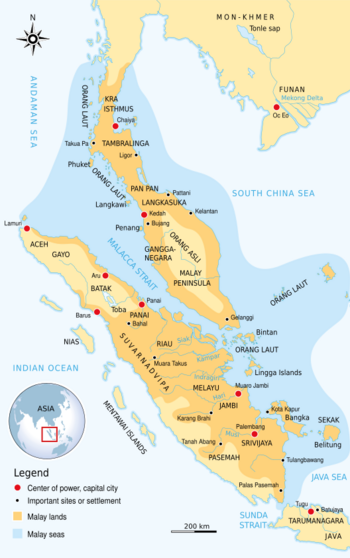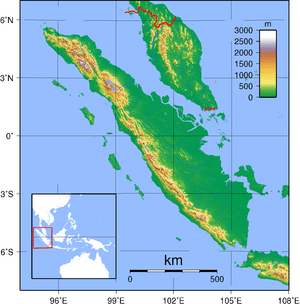Melayu Kingdom facts for kids
Quick facts for kids
Melayu Kingdom
|
|||||||||||||
|---|---|---|---|---|---|---|---|---|---|---|---|---|---|
| before 671–692 1028–1347 |
|||||||||||||

Map of ancient Melayu realm, based on a popular theory that Malayu Kingdom relates with Jambi
|
|||||||||||||
| Capital | Minanga Dharmasraya Pagaruyung |
||||||||||||
| Common languages | Old Malay, Sanskrit | ||||||||||||
| Religion | Buddhism, Hinduism | ||||||||||||
| Government | Monarchy | ||||||||||||
| Maharaja | |||||||||||||
|
• 1183
|
Trailokyaraja | ||||||||||||
|
• 1286 – 1316
|
Tribhuwanaraja | ||||||||||||
|
• 1316 – 1347
|
Akarendrawarman | ||||||||||||
| History | |||||||||||||
|
• Earliest mention
|
671 | ||||||||||||
|
• Annexed by Srivijaya
|
692 | ||||||||||||
|
• Independence restored
|
1028 | ||||||||||||
|
• Affiliated with Majapahit
|
1347 | ||||||||||||
| Currency | Gold and silver coins | ||||||||||||
|
|||||||||||||
| Today part of | |||||||||||||
The Melayu Kingdom was an ancient Buddhist kingdom. It was located in what is now West Sumatra and Jambi in Sumatra, Indonesia. It was also known as the Dharmasraya Kingdom or the Jambi Kingdom.
Most of what we know about this kingdom comes from old Chinese writings. These include the New History of the Tang and the notes of a Chinese Buddhist monk named Yijing. Yijing visited the area in 671 CE. The kingdom was taken over by Srivijaya by 692 CE. However, it became independent again by the late 1100s. Historians are still studying the exact location of the Melayu Kingdom. One idea is that it was near present-day Jambi on Sumatra. This is about 300 kilometers north of Palembang.
Contents
What's in a Name?
The name Melayu (Malay) has a few possible origins. One idea is that it comes from Javanese words. These words, melayu or mlayu, mean "to run steadily" or "to accelerate". This might describe the strong current of a river in Sumatra. Today, this river is called Sungai Melayu. People often named themselves after the rivers where they lived.
Another idea is that the name comes from the Tamil language. The words Malay and ur mean "mountain or cave" and "city, land". This could refer to the Barisan Mountains in Sumatra.

Early writings also mention the name. In an old Indian text called Vayu Purana, "Malayadvipa" means "mountainous island". It was described as a place rich in gold and silver. Some think this refers to Sumatra. Others believe it means the Malay Peninsula. This area also had a lot of gold.
The term "Maleu-Kolon" was used in Ptolemy's Geographia. This likely came from Tamil words meaning a part of the peninsula. In the 600s, the monk Yijing was the first to use "Malayu" for a nation or kingdom.
Later, in the 900s, a Javanese inscription mentioned "Malayu" forces. These forces invaded the Mataram Kingdom. This probably referred to the "Sumatran Malayu Kingdom," which might have been Srivijaya. This shows that Javanese people knew their enemies from Sumatra as "Malayu."
An inscription from the 1000s in the Brihadeeswarar Temple also mentioned Malaiyur. It was a kingdom with a "strong mountain for its rampart." This was during the Chola invasion of Srivijaya.
During the Chinese Yuan dynasty (1271–1368) and Ming dynasty (1368–1644), the word Ma-La-Yu appeared often. It referred to a nation near the southern sea. The Chinese records mentioned a conflict between Siam and Ma-li-yu-er. The Chinese emperor even sent a message telling Siam to "do no evil to Ma-li-yu-er."
The famous traveler Marco Polo also mentioned a kingdom called "Malauir" in the Malay peninsula. This was around the same time.
The words bhūmi Mālayu ("Land of Malayu") are found on the Padang Roco Inscription from 1286. It links this land to the Dharmasraya kingdom. The Amoghapasa inscription from 1347 uses Malayapura ("city of Malaya"). This also referred to Dharmasraya. The Malay annals also mention "Melayu" as a river in Sumatra.
For a while, the Chinese thought the Melayu kingdom was the new Srivijaya. This was because missions were sent to China from Jambi and Palembang in 1028. This suggests that the old Srivijaya might have fallen by 1025. Chinese records still used "Sanfoqi" for centuries, but it likely referred to the Malayu-Jambi kingdom.
A Look into History
Yijing's Journey
Our main information about the Melayu Kingdom comes from the Chinese monk Yijing. He visited the region in 671 CE. Yijing traveled through Southeast Asia and stayed in Srivijaya twice. He was there from 688 to 695, studying and translating old Sanskrit texts.
Srivijaya was doing very well when Yijing visited. He first called it "Bogha." Srivijaya grew to include Malayu. Malayu seemed to have joined Srivijaya or was taken over by it. Yijing noted that Malayu's name had changed to "Sribogha."
Yijing wrote about a monk named Wuxing. Wuxing sailed to Bogha in about a month. The king welcomed him. Then, Wuxing sailed on the king's ship to Malayu, which took 15 days.
Yijing also described Sribogha's location. He said that in the middle of the eighth month (around September), there was no shadow at midday. This means Sribogha was near the equator. This suggests it covered the northeast part of Sumatra. It stretched from the southern coast of Malacca to Palembang.
According to Yijing, most people in Srivijaya followed Hinayana Buddhism. In Malayu, there were some Mahayanists. The kingdom had a lot of gold. People used gold to make offerings and golden jars. They also wore long cloth and used fragrant oil. Melayu had access to gold-producing areas in Sumatra. This helped the kingdom become more important. It traded many local goods, including gold, with other countries.
The Melayu state was taken over by Srivijaya by 692 CE.
The Rise of Jambi
Between 1079 and 1088, Chinese records show that Srivijaya sent ambassadors from Jambi and Palembang. In 1079, both Jambi and Palembang sent ambassadors to China. Jambi sent two more in 1082 and 1088. This suggests that the main center of Srivijaya often moved between these two important cities.
The Chola invasion of Srivijaya and changes in trade routes weakened Palembang. This allowed Jambi to become the leader of Srivijaya from the 11th century onwards.
A Golden Age
By the 12th century, a new ruling family called the Mauli became very powerful in Sanfoqi (which was likely Jambi/Melayu). The first mention of this family is from an inscription in 1183. It was found in Chaiya, Southern Thailand. The inscription talks about Maharaja Srimat Trailokyaraja Maulibhusana Warmadewa. He ordered a Buddha statue to be made.
A Chinese book from around 1225, Zhu Fan Zhi, described the two most powerful kingdoms in Southeast Asia. These were Sanfoqi (Melayu/Jambi) and Java (Kediri). Sanfoqi ruled the western part (Sumatra, Malay Peninsula, and western Java). Kediri ruled the eastern part. The book said that people in Java followed Buddhism and Hinduism. People in Sanfoqi mainly followed Buddhism.
The book also listed 15 colonies of Sanfoqi. These included places like Pahang, Terengganu, Palembang, Sunda, and Jambi. This shows how widespread Sanfoqi's influence was.
The End of the Kingdom
In 1275, Kertanegara, the ruler of the Singhasari Kingdom in Java, saw that Melayu was weakening. He sent a military group to take control of Melayu's lands in Sumatra. A general named Mahesa Anabrang conquered Palembang and Jambi (Malayu) in 1288.
There's a story from the Minangkabau people about this event. It says the Javanese army was defeated in a buffalo fight. This is why the natives called themselves Minang Kabau, meaning "victorious buffalo."
After being the center of power for almost a century, Jambi's influence began to fade. This was partly because the Chinese Song dynasty stopped accepting ambassadors from Sanfotsi. Also, Jambi struggled to adapt to new trade rules. Instead of Jambi controlling trade through taxes, traders were allowed to trade directly.
By the early 1300s, Melayu was the only important state left in Sumatra. It became a place where Buddhist Indian culture continued. This was different from the northern sultanates, which were becoming Islamic.
Melayu's Last Prince
In 1347, Tribhuwana Wijayatunggadewi, the Queen of Majapahit, sent Adityawarman to rule Melayu. This was to stop Srivijaya from becoming powerful again. Adityawarman later conquered Tanah Datar to control the gold trade. He founded a new kingdom in Pagaruyung.
In 1377, the Majapahit defeated Palembang. This ended any attempts to bring Srivijaya back. The last prince from Srivijaya, Parameswara, fled to Temasik (modern-day Singapore). He then moved north and founded the Malacca Sultanate.
See Also

